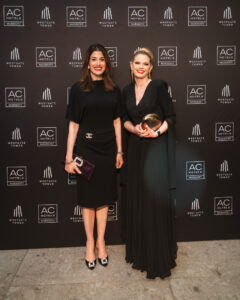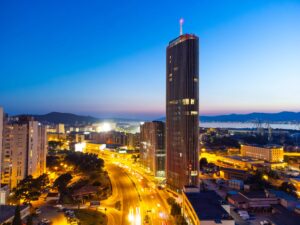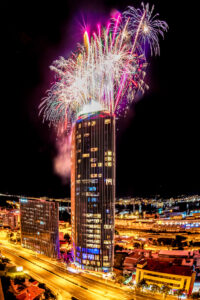In tourism, investment in luxury facilities is growing, but outside that sector, we still lack sufficient high-quality business spaces and logistics infrastructure. Croatia needs a new generation of professionals and standards to support the development of top-tier hotels, business buildings, and more complex urban zones, says Martina Jurjević, CEO of Westgate Group, in an interview for Diplomacy&Commerce. “Our ambition is to lead change in both construction and asset management. The towers are a clear representation of Westgate’s vision — we want to create spaces that not only meet the market’s needs, but go beyond them. Spaces that inspire,” says Ms. Jurjević.

- How would you rate the current real estate market in Croatia compared to the previous period, but also compared to similar markets in Europe?
The real estate market in Croatia is currently undergoing a phase of more mature development, particularly in the segment of commercial and tourism-related properties. Compared to a decade ago, there’s significantly more activity from institutional investors, as well as a growing demand for sustainable and energy-efficient buildings. It is no longer enough to build — we must create with vision. Croatia is still a market of great potential. From a European perspective, we have what many don’t: stunning nature, a high quality of life, and strong appeal as a tourist destination. However, there is still room for improvement in areas such as infrastructure, digitalization of processes, and workforce availability. Compared to earlier periods, today’s investors are better informed, ambitions are higher, and the need for global standards is increasingly pronounced.
- What’s the biggest challenge in asset management and how developed is that market in Croatia?
The main challenge is market fragmentation and a lack of standardized asset management practices. Many properties still lack professional management, which results in the gradual loss of asset value over time. The property management market in Croatia is still in a phase of development and education — both for investors and for end users. The biggest challenge is the lack of awareness that a valuable property is not just a beautiful one — it is one that is sustainable, functional, and professionally managed. Asset management is still too often seen as a cost, not as a value-adding activity. And that’s exactly where we see an opportunity for growth. Croatia needs a new generation of professionals and standards to support the development of top-tier hotels, business buildings, and complex urban areas. Our ambition is to lead that transformation.

- What are the main differences across various parts of Croatia, and how difficult is it to access premium locations?
The differences between regions and cities in Croatia are significant – Zagreb and Split definitely lead in terms of investment opportunities, but each city has its own DNA. Zagreb has the pulse of a metropolis, Split blends tradition with modernity, while cities like Zadar and Rijeka have recently begun to reveal their urban potential. The locations in coastal areas and central zones of major cities are becoming increasingly scarce, and urban plans are often not aligned with the needs of modern investments. Moreover, the complexity and sluggishness of administrative procedures further complicate access to high-quality land. That’s why our focus is placed on strategic planning and early involvement in urban development processes – this requires years of preparation, strong relationships with local communities, and a deep understanding of space. At Westgate, we don’t just look for a location – we look for a context where a project can become a symbol. That’s where the beauty lies – in creating something where others don’t yet see an opportunity.
- Which projects would you highlight, and what can we expect in the future?
Among all our projects, we would definitely highlight the Westgate Towers in Split. Designed by Otto Barić, these towers have permanently transformed Split’s skyline, giving it a contemporary edge. Tower B – Dalmatia Tower is the tallest skyscraper in Croatia and home to the country’s first Marriott hotel. Precisely these towers are a clear reflection of Westgate’s vision—we want to create spaces that not only respond to the market but exceed its expectations. Spaces that inspire. As for the future, we currently have some smaller projects underway, but we’re also actively working on several large-scale developments. Our future plans include the development of multifunctional urban zones that combine commercial, residential, and public amenities. Collaboration with top architects and urban planners allows us to shape spaces that are built to last and carry a broader social value.

- Do clients find you, or do you find them? How do you build trust?
In our sector, relationships are built on long-term trust and reputation. A large number of clients come through recommendations, but we also proactively research the market and build relationships with potential partners. Most often, we are approached by those who are looking for more—more quality, more transparency, more vision. In every project, we insist on top-level execution. The key lies in a transparent approach, open communication, and delivering on our promises.
- What are you most proud of regarding the Dalmatia Tower project, and can we expect similar developments?
We are proud to have completed a project that is not only the tallest building in Croatia, but also a symbol of modern Split—a city that successfully blends history and modernity. Dalmatia Tower sets new standards in design, functionality, and sustainability. The project has paved the way for similar ambitious investments, and we certainly plan to continue in that direction—but always with an emphasis on adaptation to the local context and long-term sustainability. Yes, you can expect similar projects. But we will not repeat ourselves—every project must have its own identity and contribute to the space it inhabits.

- How do you see the market in 5–10 years, and what are the challenges?
In the next 5 to 10 years, I expect further professionalization of the market, a greater focus on ESG criteria, and increasing integration of smart technologies into real estate. Challenges will include demographic changes, a shortage of qualified labour, and adaptation to climate requirements. It is crucial that cities and the state act as partners to investors—through more transparent and faster administrative processes, as well as through strategic spatial plans that encourage development rather than hinder it. Our responsibility is to create spaces that will serve the generations to come.